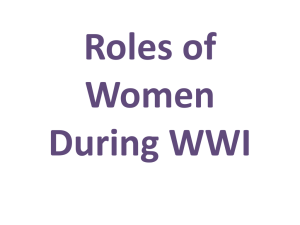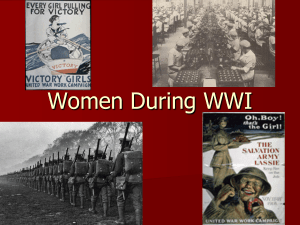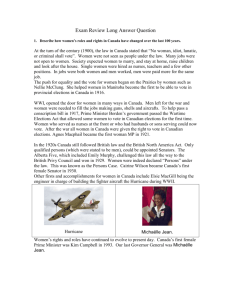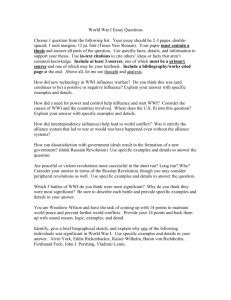SS11_Course_Overview..
advertisement
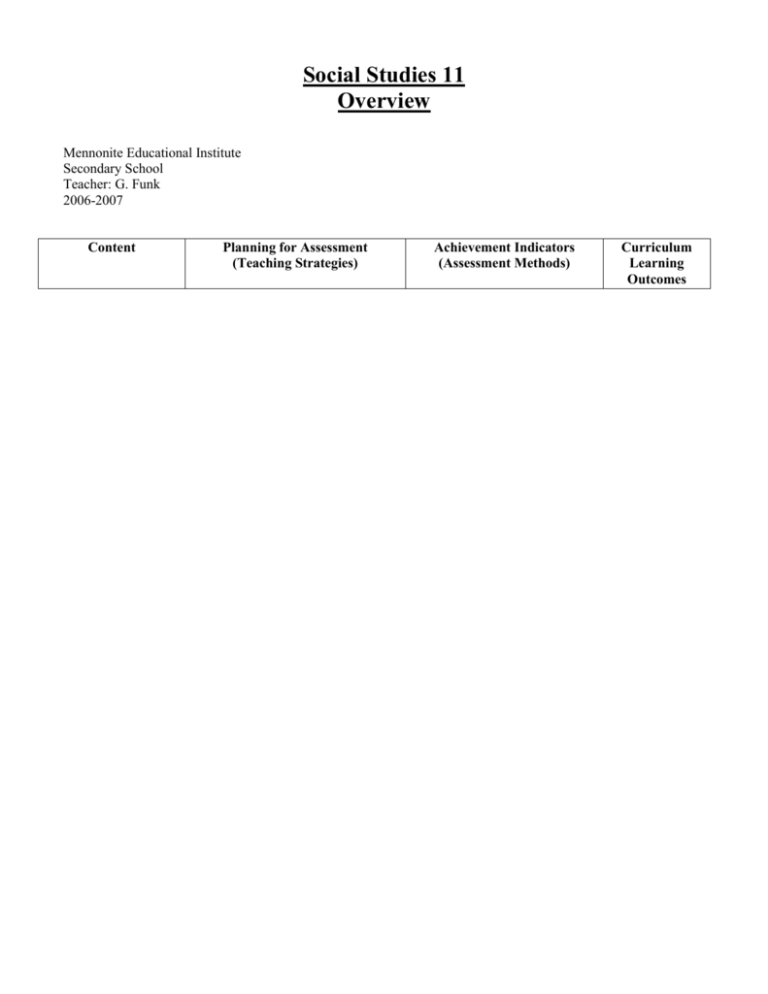
Social Studies 11 Overview Mennonite Educational Institute Secondary School Teacher: G. Funk 2006-2007 Content Planning for Assessment (Teaching Strategies) Achievement Indicators (Assessment Methods) Curriculum Learning Outcomes 2 Politics and Government 1. Canada's political system in contrast with other political systems. 2. Structure and operation of Canada's federal, provincial, and municipal governments. 3. Major provisions of the Canadian Constitution, the Canadian Charter of Rights and Freedoms, and human rights legislation 4. Political issues facing Canadians today. Text: Counterpoints: Exploring Canadian Issues Socials 11 Students Workbook (Exercises –Ex.) World War I Have students take notes of overhead on basic democracy and lecture on political ideologies and reasons for having a government using Ex. #1 and 3 (St. Workbook). Discussion of freedom vs. equality and the role of government in maintaining a balance between the two Exercise #2 and 5 (student workbook) on types of government and gov’t structures. Read Counterpoints p.226-231 and do Figures 9-9,9-10,9-11 as well as St. Workbook Ex. #6 3 Levels of Gov’t and #7 How a Bill Becomes a Law. Parliamentary simulation on how a bill becomes a law using immigration bill. Assign Ex. #8 (St. Workbook) on Canadian Constitution. Go over Cdn. Political Party Platforms and Ideologies/Spectrum using Ex. 9 and 10, whilst defending their own political opinions. Discuss how a Christian worldview may affect political preferences and decision. Students do Ex. #12 and 13 on types of government (minority, majority, etc.) and electoral systems. Students take notes on the branches of government from Ex. #17 Group discussion appropriate political action and civil disobedience using Ex. #16. Discuss in light of Biblical teachings on obedience to the government. Students read Counterpoints p. 264-267 and answer #1-3 on the role of the media and civil disobedience. Students do Ex. #19 on the Charter of Rights and Freedoms. Group discussion on application of the Charter using Ex. #20 and 21. Oral quiz on government terminology, structure, how a law is made, and levels of government. Assess student understanding of the workings of parliament using participation levels and quality of imput in a mock parliament. Students are able to articulate and defend orally their own political views on various issues during class discussion. Check student homework to assess effort and understanding. Student essay on a possible day without the Charter of Rights and Freedoms. Assess understanding of the freedoms achieved and ensured by the charter and their applications to student created scenarios. Test on Canadian Government using multiple choice and short and long written answers. Read “Village Attack” - discuss what happened from the two viewpoints. Ask students to establish fact and Alternative point of view story. Evaluate for student empathy and alternative points of view. It is expected that students will: demonstrate understanding of the political spectrum explain how Canadians can effect change at the federal and provincial levels federal and provincial governments are formed in Canada describe major provisions of the Canadian constitution, including the Canadian Charter of Rights and Freedoms, and assess its impact on Canadian society. thinking— including questioning, comparing, summarizing, drawing conclusions, and defending a position—to make reasoned judgments about a range of issues, situations, and topics demonstrate effective written, oral, and graphic communication skills skills and attitudes of active citizenship, including ethical behaviour, openmindedness, respect for diversity, and collaboration It is expected that students will: apply critical 3 opinions, and discuss bias in history. Re-write a popular event from the other side’s point of view/ or research a current event and discuss this from another’s point of view. Notes and lecture on types of sources in history, as well as tests for reliability of sources. Look at sources for the Komagata Maru Incident and evaluate them as primary or secondary, biased, etc. The Lead-up to WWI Students read p. 21-24 from Counterpoints - students do p. 24 #1,2, analyzing maps and interpreting political cartoons. Students also define bold words from this section. Students also do p. 23 “Political Cartoon” #1-5, which involves interpreting a political cartoon. Video on Pre-WWI and Alliance System “Causes of WWI”. Students review the summary of the Causes Hand-out and crossword. Tell students which notes to take during the video. Have students read and hi-light the handout. Students complete the Alliance System Map and instructions. Events and Canada’s Role Students read p. 24 – 33. Students do #1-4 from p. 28 and # 2 and 3 from p.33Letter from the Front. Do Figure 2-3 p.25 and go over as a class discussing the characteristics of recruitment posters and propaganda. Give notes on the von Schlieffen Plan and map of the invasion of France. Discuss reasons why it failed. Complete the worksheets on Canada’s Training and Beginning Effort from Counterpoints text. WWI Jigsaw/ Internet Group Project (on the Library Web Page). Students complete a group project on different aspects of the new type of warfare fought in WWI and major Canadian battles – to be presented in class using a variety of multimedia along with a summary handout. Students do major Canadian Battle worksheet #11 from Student Workbook. Go over as a class the handout – “Battle Strategies” View “WWI: Canada’s Role” video and worksheet. Students read p.34-41 in Counterpoints and do #1, 3 from p.39 and #1, 2, 4, 5 from p.42. (possibly #3- election poster) do Figure 2-18 p.40 on the effects of the Battle of Passchendaele. Check homework for depth of understanding of the causes of WWI. Check for accuracy of the Alliance System map. Small fill-in-the-blank quiz on the causes of WWI. Group presentation on specific aspects of warfare in WWI. Assess for depth of understanding and effective communication. Large test on the WWI to 1917. The test will include multiple choice, matching, true and false, cartoon interpretation, map depiction, short and long written answers. Student participation in and preparation for the debate on Germany’s war guilt clause. Students to write an essay on the Treaty of Versailles. Depth of critical thinking and analysis of the clauses to be stressed. Second test on the ending of WWI in multiple choice format. thinking— including questioning, comparing, summarizing, drawing conclusions, and defending a position—to make reasoned judgments about a range of issues, situations, and topics demonstrate effective research skills, including information information information information demonstrate effective written, oral, and graphic communication skills skills and attitudes of active citizenship, including ethical behaviour, openmindedness, respect for diversity, and collaboration describe Canada’s evolution as a politically autonomous nation assess Canada’s role in World War I and the war’s impact on Canada. describe the role of women in terms of social, political, and economic change in Canada impact of the 4 The End of WWI Students read p. 42-46 and do figure 221 questions and map on the redrawing of Europe. Students also do #3 p. 46. Ex. 15 and 16 from the Student Workbook on the War at Home and The Changing Role of Women. Show Russian Revolution Video and do handout. Lecture on the role the revolution had on WWI. Lecture on infiltration and the advent of tank warfare in drawing the war to a close suing Battle Strategies notes. Conduct a formal debate on Germany’s War Guilt Clause. Have a panel of three judges decide who wins the debate. OR Conduct a trial to determine Germany’s guilt or innocence in starting WWI. Use the additional information for the lawyers. Witnesses must help in the development of the case Do Treaty of Versailles response paper. Students write an essay in which they analyze the appropriateness of the treaty’s points and the fairness of the war guilt clause. The 1920’s and 1930’s The Roaring Twenties – place posters around the room. Read p. 49-53 Students do the associated handout and define bold terms/do Figure 3-1 Students do #2, 3, 4 (expand number 4 to include unions today and the right to strike, for marks) Discuss the effects on Canada our Labour Movement and reasons for Winnipeg General Strike. Students do p. 52-53 Developing a Thesis for a Research Paper do either #3 p.53 or #4 p. 51 – not both. Have students create the thesis statements, but not write the essay. Show “The Roaring Twenties” Video. Discuss the comparison with and influence of the United States’ experience. Read p. 55 – 65 / define the bold term/ cover primary and secondary industries/ core and perimeter/ tertiary/ do Figure 38 from p.59 – students create U-do’s (creating questions for a partner to answer) on this section. Do 1920’s Politics Quiz (multiple choice) focusing on minority governments. Read p.66-67 and discuss Canada’s sovereignty and independence. conscription crises, Quebec nationalism, bilingualism, and regionalism on Canadian unity check homework for effort and depth of understanding assess written thesis; for depth of understanding and ability to formulate. Multiple choice quiz to assess understanding of 1920’s politics Life and Entertainment Project – students choose from a number of options (newspaper articles, radio programs, comic strips, etc.) to illustrate their understanding of life in the 20;s and 30’s Multiple choice test on the 20’s and 30’s It is expected that students will: apply critical thinking— including questioning, comparing, summarizing, drawing conclusions, and defending a position—to make reasoned judgments about a range of issues, situations, and topics demonstrate effective research skills, including information information - information information 5 Read p.72 – do#1-4 Stock Market Crash Game – students form teams and purchase a variety of stock to show the effect of the stock market crash. The Dirty Thirties Lecture and notes on Economic Conditions and Causes of the 20’s and 30’s. Read p.75-91 students do p,79 #2, #14/ p.81 Using Statistics – students interpret graphs and charts depicting depression conditions/ p. 84-85 #1-4 and Figure 4-7/ p.86 #1-3, p.89 #1-2/ p.90 #1 - split this up while students complete the project. Twenties and Thirties Project – students choose from a number of options to demonstrate their understanding of life in the 20’s and 30’s. Test on the 20’s and 30’s using multiple choice. demonstrate effective written, oral, and graphic communication skills describe Canada’s evolution as a politically autonomous nation explain economic cycles with reference to the Great Depression and the labour movement in Canada describe the role of women in terms of social, political, and economic change in Canada 6 World War Two The Prelude to War Show Hitler’s rise to power video and take notes as a class. Read p. 92-98 and do p.98 # 1-5 and define bold terms in this section. Discuss the rise of totalitarian states. Discuss the political spectrums and Canadian political parties. - discuss in relation to world events prior to 1939. Discuss anti-Semitism in Canada prior to and during WWII War Notes handed out and the major events of WWII explained in lecture format. Do map on Europe in 1941. Watch Videos on Canada’s involvement “Canada and World War II” Canada at War series. World at War Series. Play Origins of WWII game as review. Continue notes and videos. Readings for appropriate sections and lectures based on handouts. - p.101 –105 p.105 #2-4 Canadian response to WWII announcement/p. 106 – 110 p. 110 #103 B of Britain, Barbarossa, Dieppe/ p. 111- 115 p. 115 # 3-4 Battle of the Atlantic, Air war /p. 114 “Reading a Historical Map” #23/ p. 115-122 D-Day Landings, Holocaust, Japan Surrenders/do section on the Holocaust./ p. 120-121 Use of Weapons of Mass Destruction #1-4 /p. 122-125 #103 Conscription and the War at Home./p. 126-127 #1-3 Japanese Internment. Show “Decision to Drop the Bomb” Video. Students do essay response to legitimacy of dropping the bomb. Students do Informal Fallacies Worksheet after instructions on faulty reasoning. Instruct students on the difference between Deductive/Inductive Reasoning and have them complete a paper on various WWII topics. WW II Test #2 Test #1 – up to 1943 – matching and short answer/ map depiction and long answers. Check student homework for insight and depth of understanding. Check WWII map for correct depiction of Nazi control in 1941. Student essay response to “The Decision to Drop the Bomb”. Check for understanding and critical analysis of reasons. Inductive/Deductive Reasoning Paper – analyze for depth of research and understanding, as well as critical analysis and understanding of reasoning style. Test #2 – multiple choice test on remaining WWII section. It is expected that students will: apply critical thinking— including questioning, comparing, summarizing, drawing conclusions, and defend a position—to make reasoned judgments about a range of issues, situations, and topics demonstrate effective research skills, including access information assess information information present information cite sources demonstrate effective written, oral, and graphic communication skills Students will also: describe Canada’s evolution as a politically autonomous nation assess Canada’s role in World War II and the war’s impact on Canada The Cold War Era and Beyond The Cold War Students complete worksheets from p. 131-136 being sure to define capitalist, socialist, communist. Discuss the arms race and effects on Canada. Watch “Trinity and Beyond” Discuss the significance of the development of nuclear weapons. Read pages 137-144 and do p. 139 #15/ p. 141 Avro Arrow #1-2/ Interpreting Visuals p. 143 #1-3. Discuss how Check homework for insight and depth of understanding. Cold War Test – test for understanding of the role Canada played in the arms race and various crisis from this time period. It is expected that students will: describe Canada’s evolution as a politically autonomous nation assess Canada’s participation in 7 French and Aboriginal Affairs Canada became a middle power. Discuss the effects of American influence on Canada during the Cold War. Play Cold War Diplomacy Game. Have students empathize with the decision-making process for governments in times of crisis. Read p. 144-145 “The Vietnam War” – do #1-4 p. 146 and show “Dear America” (edit for scenes and language), Discuss the impacts of war on a soldier. Discuss the reasons for war from various perspectives, including the enemy’s perspective. Cold War Test – matching/true or false/ short answer. Test for the understanding of key issues during the Cold War. Have students complete the student worksheets from the Socials 11 Student Workbook relating to chapters 7 and 8. Us them as a guide towards discussing the evolution of the Canadian government’s stance on the Indian Act, the White Paper, residential schools, and other issues regarding aboriginal peoples. Use the worksheets as a platform to debate the issue of French language rights and Quebec nationalism. Reference will be made to the Quiet Revolution, 2 official languages, Bill 101, the FLQ crisis, the Kitchen Compromise, the Charlottetown Accord and the Meech Lake Accord; as well as the referendums and ‘98 Supreme Court Decision. Students will be encouraged to understand these issues from all sides of the debate. world affairs with reference to conflicts Homework Checks to determine level of understanding and effort to understand. Test – multiple choice in nature to determine ability to recall facts and to apply these facts to past, present, and future events. It is expected that students will: assess the impact of Quebec nationalism, bilingualism, and regionalism on Canadian unity demonstrate knowledge of the challenges faced by Aboriginal people in Canada during the 20th century and their responses, with reference to schools, government, and negotiations assess the development and impact of Canadian social policies and programs related to immigration, the welfare state, and minority rights. apply critical thinking— including questioning, comparing, summarizing, drawing conclusions, and 8 Trudeau until the end Watch “Canada This Century” video – 1960’s to the 1970’s. Discuss how Canada changed as a society with regards to cultural values and its identity crisis. Read p. 146-150 and do #1-4/ Read p. 152-156 End of the Cold War and do #25 p. 156. Discuss the significance of Canada’s influence on closer relations with communist nations. Read pages 190-198 and have students do p. 197 Assessing Viewpoints #1-5. Discuss the significance of Quebec nationalism and the FLQ crisis. Test – multiple choice Homework – checking for understanding of French/English relations. Test – multiple choice testing understanding of French/English relations. World Population Begin unit by giving notes on globalization and the global village. Students will be made aware of our “shrinking” world due to advances in communication and transportation. Population Terms – from p. 317-336 Students copy down definitions. Read p. 317-322. Students do population growth model exercise and discuss reasons for the growth differences. Notes on doubling time and do p. 322 #3. Discuss the implications of doubling time for the developing world. Do p.319 #1 –2 in the library. Set the countries that are to be analyzed. (North American, NW European, southern Asian, central African) Afghanistan, Japan, India, Canada. Check their population pyramids, birthrate, death rate, current population. Discuss the differences and the implications for each nation. Notes on the demographic transition model. Read p. 322- 325 and do p.323 Figure 13-6 and 13-7 and Figure 13-9. Give instruction on Population Pyramids and have students do the exercise and read p. 325- 328. Do p.326 Figure 13-10 #1-5 and Figure 13-13 #14. Discuss how population pyramids can reveal future trends and what those trends will mean to each nation. Discuss China’s one-child policy and the issue of male-child preference. Homework Checks – students show their depth of understanding of population issues. World Population Map and Population Distribution Assignment – evaluate students’ understanding of spatial distribution and the determiners of population distribution. Test on Population – a combination of matching, multiple choice, short answers, diagram and map questions, and essay questions designed to show the students depth of understanding of related issues. defend a position—to make reasoned judgments about a range of issues, situations, and topics. It is expected that students will be able to demonstrate an understanding of what it means to be Canadian with reference to distinctive Canadian programs and policies demonstrate an understanding of important Canadian cultural and scientific achievements. It is expected that students will: explain the significance of changes in world population with reference to pyramids, distribution, demographic transition models. 9 Standard of Living Economics and the Environment. Students do population map and population distribution exercise using the atlas. Then read p.332-334 and do p.334 #1-2. Discuss factors leading to population density. Notes on Thomas Malthus and carrying capacity. Optional: Read p.335-337. Discuss the implications to world resources and environment of an ever-expanding population. The People Bomb Video – and sheet. Students discuss the implications of population growth on the women of developing nations. Hong Kong slides – ideas of population density will be revealed by viewing it on China’s eastern coast. Test on Population – a combination of matching, multiple choice, short answers, diagram and map questions, and essay questions. The Savage Country – students read and discuss qualifiers for standard of living by comparing Canada in 1900 and present day. Students take notes on the qualifiers of standard of living and the UN Human Development Index. Students complete Activity 3-1: Doctors and Life Expectancy and discuss positive and negative correlation and relationships. Stundets read p.341-345 and do p. 342 Figure 14-2 #1-4. Discuss the disparity between the developed world and the developing world and reasons behind this difference. Read p. 346 and answer #3 together as a class. Discuss the poverty cycle and ways to break it. Test – multiple choice. students will do economic worksheets from the student workbook and discover the concepts of core and periphery, primary industries, secondary industries, etc. Students receive a handout on environmental issues and concerns and relate them to the video “An Inconvenient Truth“. Students will be encouraged to look for any bias in the video. Multiple Choice Test – on key concepts of environmental issues and economic concepts. Homework check – for depth of understanding. Test – multiple choice to determine understanding of key terms and concepts. It is expected that students will: compare Canada’s standard of living with those of developing countries, with reference to poverty and key indicators of human development. Homework Checks for depth of understanding and effort to understand key concepts. Mutliple Choice Test – students show their understanding of key concepts and issues in economics and environmental issues. It is expected that students will: assess environmental challenges facing Canadians, layer depletion, quality and supply.
